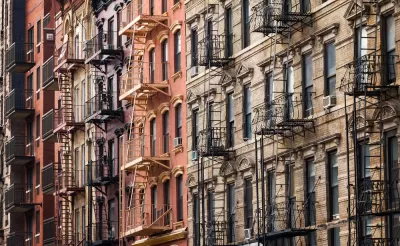Laws that control rent-stabilized apartments have been weakened over the last 25 years while the surging economy drives many of these units into the free market.

Kim Barker, a Metro desk reporter for The New York Times, paints a grim picture of the one million rent-stabilized apartments in New York City, "the city’s largest stock of affordable housing, where rents are set at a prescribed level and are supposed to increase only a small amount each year." Barker refers to them as rent-regulated, a term that includes a much smaller group of "highly coveted rent-controlled apartments [that] still exist in some pockets of the city," writes Emily Nonko of Curbed New York.
Rent stabilization generally applies to privately owned buildings containing at least six units built before 1974, according to the Metropolitan Council on Housing.
"These apartments — seen as the scourge of landlords and the salvation of struggling New Yorkers — are at the center of a housing crisis that has swelled the ranks of the homeless and threatens to squeeze all but the affluent from ever-wider swaths of the city," writes Barker, an investigative journalist, in a deep dive into what's gone wrong with rent-stabilization in New York City, "the nation’s largest rent-regulation system."
"Since 1994, at least 152,147 units were registered with the New York State Homes and Community Renewal as being deregulated due to High-Rent Vacancy Deregulation, 70% of which have been in Manhattan," according to a report [pdf] released last May by the New York City Rent Guidelines Board. Barker explains how high rent, ironically, results in the loss of tenant protections.
In neighborhoods already gentrified and in the throes of gentrifying, a relatively new class of mega-landlords has driven up rents by exploiting enforcement gaps in a web of city and state agencies. By churning through enough tenants and claiming enough renovations, landlords can raise the rent enough — beyond $2,733.75 a month — to wrest an apartment from regulation’s grip and into the free market.
In addition to losses due to High Rent Vacancy Deregulation, "[a]t least 130,000 more have disappeared because of co-op and condo conversions, expiring tax breaks and other factors," adds Barker. "And while government officials say the losses have slowed, even regulated apartments are becoming increasingly unaffordable."
One of the main weaknesses of the rent stabilization program is that the "regulatory apparatus is fractionalized, divided among three city and state agencies," explains Barker. "At the same time, the city’s housing court mired in chaos, cannot reliably weed out frivolous and abusive lawsuits."
In place of regulatory muscle, The Times found, the system relies on trust: trust that landlords do the right thing, trust that architects and engineers submit accurate permit applications, trust that landlords report rental histories correctly, trust that eviction suits are legitimate.
One finding of The Times investigation was how an apartment building in Harlem containing 66 units on 11 floors has changed due to tenants moving out (rents can increase 20 percent) and renovations. In 1996, the entire building was regulated, with both stabilized and controlled units. The average rent for the former was about $870 per month, adjusted for inflation.
By 2018, 19 units (29 percent) had been "lost to the free market." Average rent for the stabilized units was $1,218, while the market-rate units were over three times as much, $3,875.
When buildings change hands
Problems for tenants often occur when buildings are sold to corporate landlords who seek to "unlock the value" of the regulated units.
To breach the $2,733.75 threshold, mega-landlords and aspiring ones tend to follow the same playbook: After buying a building, they try to get tenants in regulated apartments to leave, often offering buyouts or harassing them with poor services or eviction suits. Once an apartment is empty, they tack on allowed vacancy increases. They often also perform renovations, enabling them to raise the rent even further while annoying remaining neighbors,B sometimes to the point of prompting them to leave.
Barker provides many examples of how landlords, using shady practices, force long-term tenants to leave their apartments, and generally get away with it because of lax regulations. The article is a long, and sadly depressing read on the state of tenant protections in New York City.
FULL STORY: Behind New York’s Housing Crisis: Weakened Laws and Fragmented Regulation

Alabama: Trump Terminates Settlements for Black Communities Harmed By Raw Sewage
Trump deemed the landmark civil rights agreement “illegal DEI and environmental justice policy.”

Planetizen Federal Action Tracker
A weekly monitor of how Trump’s orders and actions are impacting planners and planning in America.

The 120 Year Old Tiny Home Villages That Sheltered San Francisco’s Earthquake Refugees
More than a century ago, San Francisco mobilized to house thousands of residents displaced by the 1906 earthquake. Could their strategy offer a model for the present?

In Both Crashes and Crime, Public Transportation is Far Safer than Driving
Contrary to popular assumptions, public transportation has far lower crash and crime rates than automobile travel. For safer communities, improve and encourage transit travel.

Report: Zoning Reforms Should Complement Nashville’s Ambitious Transit Plan
Without reform, restrictive zoning codes will limit the impact of the city’s planned transit expansion and could exclude some of the residents who depend on transit the most.

Judge Orders Release of Frozen IRA, IIJA Funding
The decision is a victory for environmental groups who charged that freezing funds for critical infrastructure and disaster response programs caused “real and irreparable harm” to communities.
Urban Design for Planners 1: Software Tools
This six-course series explores essential urban design concepts using open source software and equips planners with the tools they need to participate fully in the urban design process.
Planning for Universal Design
Learn the tools for implementing Universal Design in planning regulations.
Clanton & Associates, Inc.
Jessamine County Fiscal Court
Institute for Housing and Urban Development Studies (IHS)
City of Grandview
Harvard GSD Executive Education
Toledo-Lucas County Plan Commissions
Salt Lake City
NYU Wagner Graduate School of Public Service





























